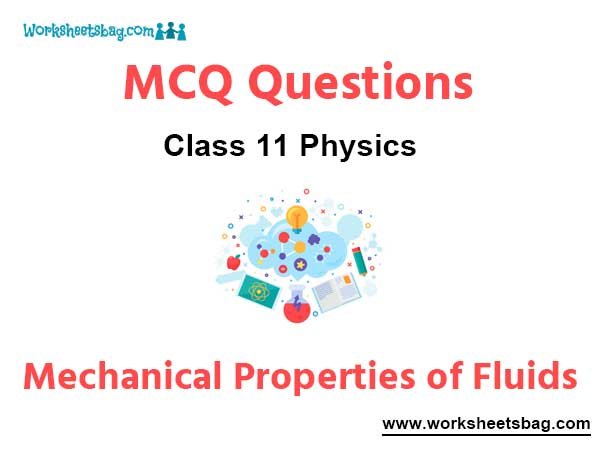Please refer to Mechanical Properties of Fluids MCQ Questions Class 11 Physics below. These MCQ questions for Class 11 Physics with answers have been designed as per the latest NCERT, CBSE books, and syllabus issued for the current academic year. These objective questions for Mechanical Properties of Fluids will help you to prepare for the exams and get more marks.
Mechanical Properties of Fluids MCQ Questions Class 11 Physics
Please see solved MCQ Questions for Mechanical Properties of Fluids in Class 11 Physics. All questions and answers have been prepared by expert faculty of standard 11 based on the latest examination guidelines.
MCQ Questions Class 11 Physics Mechanical Properties of Fluids
Question. The difference between viscosity and solid friction is/are
(a) viscosity depends on area while solid friction does not
(b) viscosity depends on nature of material but solid friction does not
(c) both (a) and (b)
(d) neither (a) nor (b)
Answer
A
Question. Water is flowing through a horizontal pipe having a restriction, then
(a) pressure will be greater at the restriction.
(b) pressure will be greater in the wider portion.
(c) pressure will be same throughout the length of the pipe.
(d) None of these
Answer
B
Question. Water is not used in thermometer because
(a) it sticks to glass
(b) its shows anamalous expansion
(c) both (a) and (b)
(d) neither (a) nor (b)
Answer
C
Question. The terminal velocity depends upon
(a) 1/1
(b) 1/r2
(c ) 1/r3
(d) r2
Answer
D
Question. At the boiling point of a liquid, surface tension
(a) is zero
(b) is infinite
(c) is same as that at any other temperature
(d) cannot be determined
Answer
A
Question. A small ball (menu) falling under graivty in a viscous medium experiences a drag force proportional to the instantaneous speed u such that Fdrag = Ku . Then the terminal speed of the ball within the viscous medium is

Answer
B
Question. A liquid is contained in a vessel. The liquid-solid adhesive force is very weak as compared to the cohesive force in the liquid. The shape of the liquid surface will be
(a) horizontal
(b) vertical
(c) concave
(d) convex
Answer
D
Question. The velocity of efflux of a liquid through an orifice in the bottom of the tank does not depend upon
(a) size of orifice
(b) height of liquid
(c) acceleration due to gravity
(d) density of liquid
Answer
A
Question. Two liquids drops coalesce to form a large drop. Now,
(a) energy is liberated
(b) energy is neither liberated nor absorbed
(c) some mass gets converted into energy
(d) energy is absorbed
Answer
A
Question. A liquid is allowed to flow into a tube of truncated cone shape. Identify the correct statement from the following.
(a) The speed is high at the wider end and high at the narrow end.
(b) The speed is low at the wider end and high at the narrow end.
(c) The speed is same at both ends in a stream line flow.
(d) The liquid flows with uniform velocity in the tube.
Answer
B
Question. The lift of an air plane is based on
(a) Torricelli’s theorem
(b) Bernoulli’s theorem
(c) Law of gravitation
(d) conservation of linear momentum
Answer
B
Question. A man is sitting in a boat which is floating in pond. If the man drinks some water from the pond, the level of water in the pond will
(a) rise a little
(b) fall a little
(c) remain stationary
(d) none of these
Answer
C
Question. Surface tension may be defined as
(a) the work done per unit area in increasing the surface area of a liquid under isothermal condition
(b) the work done per unit area in increasing the surface area of a liquid under the adiabatic condition
(c) the work done per unit area in increasing the surface area of liquid under both isothermal and adiabatic condition
(d) free surface energy per unit volume
Answer
A
Question. The surface energy of a liquid drop of radius r is proportional to
(a) r3
(b) r2
(c) r
(d) 1/r
Answer
B
Question. Consider a 1 c.c. sample of air at absolute temperature T0 at sea level and another 1 c.c. sample of air at a height where the pressure is one-third atmosphere. The absolute temperature T of the sample at the height is
(a) equal to T0/3
(b) equal to 3/T0
(c) equal to T0
(d) cannot be determined in terms of T0 from the above data
Answer
A
Question. A liquid does not wet the sides of a solid, if the angle of contact is
(a) Zero
(b) Obtuse (more than 90°)
(c) Acute (less than 90°)
(d) 90° (right angle)
Answer
B
Question. The reading of spring balance when a block is suspended from it in air is 60 newton. This reading is changed to 40 newton when the block is submerged in water. The specific gravity of the block must be therefore
(a) 3
(b) 2
(c) 6
(d) 3/2
Answer
A
Question. The level of water in a tank is 5m high. A hole of area 1 cm2 is made in the bottom of the tank. The rate of leakage of water from the hole (g = 10 m/s2) is
(a) 10–2 m3/s
(b) 10–3 m3/s
(c) 10–4 m3/s
(d) 103 m3/s
Answer
B
Question. Gases do not posses
(a) density
(b) surface tension
(c) volume
(d) viscosity
Answer
B
Question. Paint-gun is based on
(a) Bernoulli’s theorem
(b) Archimedes’ principle
(c) Boyle’s law
(d) Pascal’s law
Answer
A
Question. A spherical ball of iron of radius 2 mm is falling through a column of glycerine. If densities of glycerine and iron are respectively 1.3 × 103 kg/m3 and 8 × 103 kg/m3. h for glycerine = 0.83 Nm–2 sec, then the terminal velocity is
(a) 0.7 m/s
(b) 0.07 m/s
(c) 0.007 m/s
(d) 0.0007 m/s
Answer
B
Question. 8 mercury drops coalesce to form one mercury drop, the energy changes by a factor of
(a) 1
(b) 2
(c) 4
(d) 6
Answer
C
Question. If a water drop is kept between two glass plates, then its shape is

Answer
C
Question. In case A, when an 80 kg skydiver falls with arms and legs fully extended to maximize his surface area, his terminal vel ocity is 60 m/s. In Case B, when the same skydiver falls with arms and legs pulled in and body angled downward to minimize his surface area, his terminal velocity increases to 80 m/s. In going from Case A to Case B, which of the following statements most accurately describes what the skydiver experiences?
(a) Fair resistance increases and pressure P increases
(b) Fair resistance increases and pressure P decreases
(c) Fair resistance decreases and pressure P increases
(d) Fair resistance remains the same and pressure P increases
Answer
D
Question. A ring is cut from a platinum tube 8.5 cm internal and 8.7 cm external diameter. It is supported horizontally from the pan of a balance, so that it comes in contact with the water in a glass vessel. If an extra 3.97. If is required to pull it away from water, the surface tension of water is
(a) 72 dyne cm–1
(b) 70.80 dyne cm–1
(c) 63.35 dyne cm–1
(d) 60 dyne cm–1
Answer
A
Question. The fraction of a floating object of volume V0 and density d0 above the surface of liquid of density d will be

Answer
B
Question. An open vessel containing water is given a constant acceleration a in the horizontal direction. Then the free surface of water gets sloped with the horizontal at an angle θ, given by

Answer
D
Question. A cylinder of height 20m is completely filled with water. The velocity of efflux of water (in ms–1) through a small hole on the side wall or the cylinder near its bottom is
(a) 10 m/s
(b) 20 m/s
(c) 25.5 m/s
(d) 5 m/s
Answer
B
Question. Two drops of the same radius are falling through air with a steady velocity of 5 cm per sec. If the two drops coalesce, the terminal velocity would be
(a) 10 cm per sec
(b) 2.5 cm per sec
(c) 5 × (4)1/3 cm per sec
(d) 5´ 3 cm per sec
Answer
C
Question. A tank is filled with water upto a height H. Water is allowed to come out of a hole P in one of the walls at a depth h below the surface of water (see fig.) Express the horizontal distance X in terms H and h.

Answer
C
Question. Water rises to a height of 10 cm in capillary tube and mercury falls to a depth of 3.1 cm in the same capillary tube. If the density of mercury is 13.6 and the angle of contact for mercury is 135°, the approximate ratio of surface tensions of water and mercury is
(a) 1 : 0.15
(b) 1 : 3
(c) 1 : 6
(d) 1.5 : 1
Answer
C
Question. A big drop of radius R is formed by 1000 small droplets of water. The radius of small drop is
(a) R/10
(b) R/100
(c) R/500
(d) R/1000
Answer
A


